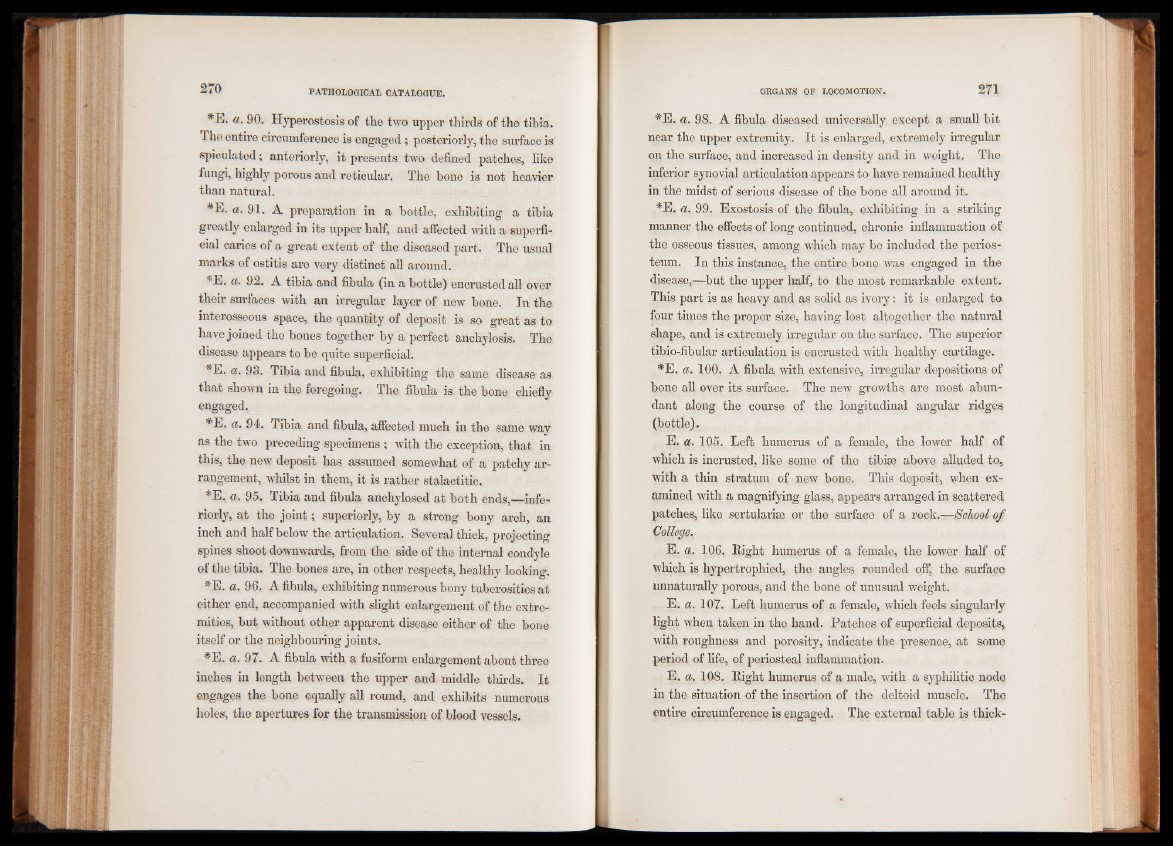
*E. a. 90. Hyperostosis of the two upper thirds of the tibia.
The entire circumference is engaged; posteriorly, the surface is
spiculated; anteriorly, it presents two defined patches, like
fungi, highly porous and reticular. The bone is not heavier
than natural.
#E. a. 91. A preparation in a bottle, exhibiting a tibia
greatly enlarged in its upper half, and affected with a superficial
caries of a great extent of the diseased part. The usual
marks of ostitis are very distinct all around.
*E. 92. A tibia and fibula (in a bottle) encrusted all over
their surfaces with an irregular layer of new bone. In the
interosseous space, the quantity of deposit is so great as to
have joined the bones together by a perfect anchylosis. The
disease appears to be quite superficial.
*E. a. 93. Tibia and fibula, exhibiting the same disease as
that shown in the foregoing. The fibula is the bone chiefly
engaged.
*E. a. 94. Tibia and fibula, affected much in the same way
as the two preceding specimens ; with the exception, that in
this, the new deposit has assumed somewhat of a patchy arrangement,
whilst in them, it is rather stalactitic.
*E, a. 95. Tibia and fibula anehylosed at both ends,—infe-
riorly, at the jointsuperiorly, by a strong bony arch, an
inch and half below the articulation. Several thick, projecting
spines shoot downwards, from the side of the internal condyle
of the tibia. The bones are, in other respects, healthy looking.
*E. a. 96. A fibula, exhibiting numerous bony tuberosities at
either end, accompanied with slight enlargement of the extremities,
but without other apparent disease either of the bone
itself or the neighbouring joints.
#E. a. 97. A fibula with a fusiform enlargement about three
inches in length between the upper and middle thirds. It
engages the bone equally all round, and exhibits numerous
holes, the apertures for the transmission of blood vessels.
#E. a. 98. A fibula diseased universally except a small bit
near the upper extremity. It is enlarged, extremely irregular
on the surface, and increased in density and in weight. The
inferior synovial articulation appears to have remained healthy
in the midst of serious disease of the bone all around it.
*E, a. 99. Exostosis of the fibula, exhibiting in a striking
manner the effects of long continued, chronic inflammation of
the osseous tissues, among which may be included the periosteum.
In this instance, the entire bone was engaged in the
disease,—but the upper half, to the most remarkable extent.
This part is as heavy and as solid as ivory: it is enlarged to
four times the proper size, having lost altogether the natural
shape, and is extremely irregular on the surface. The superior
tibio-fibular articulation is encrusted with healthy cartilage.
*E. a. 100. A fibula with extensive, irregular depositions of
bone all over its surface. The new growths are most abundant
along the course of the longitudinal angular ridges
(bottle).
E. a. 105. Left, humerus of a female, the lower half of
which is incrusted, like some of the tibise above alluded to,
with a thin stratum of new bone. This deposit, when examined
with a magnifying glass, appears arranged in scattered
patches, like sertularise or the surface of a rock.—School of
College.
E. a. 106. Right humerus of a female, the lower half of
which is hypertrophied, the angles rounded off, the surface
unnaturally porous, and the bone of unusual weight.
E. a. 107. Left humerus of a female, which feels singularly
light when taken in the hand. Patches of superficial deposits,
with roughness and porosity, indicate the presence, at some
period of life, of periosteal inflammation.
E. a. 108. Right humerus of a male, with a syphilitic node
in the situation of the insertion of the deltoid muscle. The
entire circumference is engaged. The external table, is thick